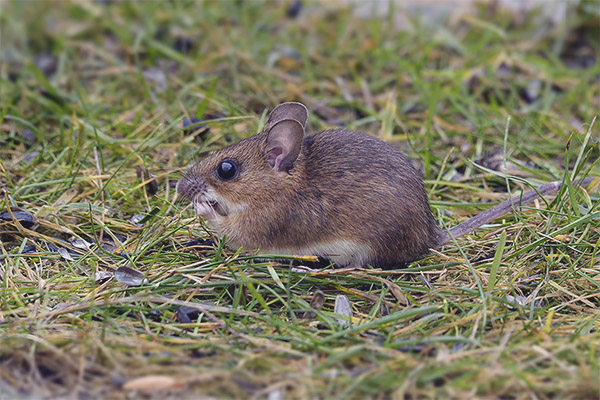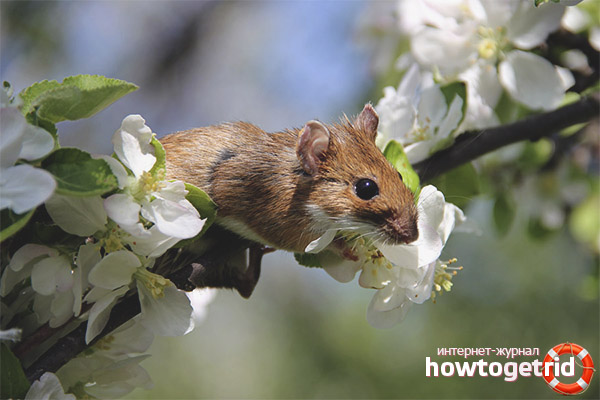The content of the article
Some at the sight of the mouse immediately go into horror, in others this nice little animal causes indescribable delight. In this material, we will consider a miniature representative, who is called nothing but a yellow-necked mouse. It is distinguished by its habits, ways to get food and features to communicate with yourself. Let's take a look at the main aspects related to these animals so that you can form your own opinion.
Description
- This animal is quite small, extending no more than 13 cm along the length of the body. However, often there are much more miniature members of the family. In addition, the tail is still about 13 cm. Often it is slightly longer than the body. These mice are famous for their large and thin ears, they are 2 cm in height.
- The main characteristic of the variety is pigmentation.The fur is dyed ocher, brown, red or brownish. On the back there is a black strip of black. The abdominal part is lightened, almost white, but dark outlines can be observed closer to the sides. On the chest there is a round or oval spot, pigmented by yellow. Partly for this reason, the mouse is so called. In some cases, a ring of yellowish tone may be present on her neck.
- The format of the head is wedge-shaped, it is slightly larger than that of forest mice. Also in the lower part of the neck there are bright outlines that other relatives do not have. The tail and ears are elongated, these are also the main differences of the variety under discussion. It is these distinctive characteristics allowed to distinguish yellow-throated representatives into a separate species.
Habitat
- It is impossible to say that individuals from this family are found everywhere, but they are also rarely called. To a greater extent, mice are common in mountainous and forest belts, live in Europe, in the open spaces of our country and surrounding areas. A lot of family members in Ukraine.From the regions of Russia we will single out the distribution in the Caucasus and the Crimea. These animals love warm climatic regions, respectively, and the terrain is chosen according to their preferences. They are found in the British Isles.
- These animals love larches, in particular oak forests. They can settle in a mixed zone, as long as there is food and a suitable climate. Mice need larch. Animals do not leave their territory of distribution, because except for the forests, they are not adapted to anything. If ordinary mice can live almost everywhere, then yellow-necked representatives are not capable of this.
- Partly due to addiction to the larch zones, some places are not populated, even if there is food, but there is no broadleaf. Many of the discussed individuals living in the Caucasus and the Carpathians, in summer, climb above the level of the forest. By the end or the middle of a warm pore, they can go down to feed. In winter, the animals try to hide in residential or household buildings.
Lifestyle
- Animals most of the time are active at night.They can live in hollows, and at different heights. Some dig minks in the root system of trees; these tunnels reach a depth of 1.5 meters. What is enough for such small animals. Burrows are necessarily equipped with extended areas called cameras. In them, mice rest, raise offspring.
- Presented animals more often than all the rest of their relatives occupy the nests of birds and live in them. Here they bring stocks for the winter, here they can multiply (if there is no camera in the hole, or there is no hole in fact). In some particularly voracious rodents, the reserves by weight can reach 5 kg. These individuals do not hibernate.
- Mice eat seeds to a greater extent. They stock up on acorns, nuts, maple, hazel, linden, etc. Also, some eat shrub seeds. The menu includes shoots and leaves. Cultivars are consumed long before ripening.
Breeding
- It is noteworthy that the individuals in question are capable of bringing up to 4 broods per year. At the same time, on average, about 6 cubs are born.
- After birth, babies stay with their mother for some time.They reach sexual maturity this year.
- Otherwise, the number of such individuals will directly depend on the yield of deciduous plants. Such mice die in large numbers in frosty and snowy winters.
Economic value
- Unfortunately, the presented individuals cause significant damage to agricultural crops. Such mice damage watermelons, carrots, tomatoes, potatoes, sunflowers and cereals.
- It is interesting that some farmers were forced to stop planting oak due to the fact that rodents completely destroyed the sowing and young shoots.
- Do not forget that individuals act as prey for fur animals. Therefore, there is some benefit in this.
- The problem also lies in the fact that the rodents discussed suffer from quite serious diseases in the form of leptospirosis, tick-borne encephalitis and tularemia.
Characteristics
- An interesting feature of such individuals is that the populations that live closer to the south have much smaller sizes, unlike animals that live to the west and north of the regions of Russia.
- Individuals living in the south side have a brighter and more pronounced color. It is also brown. In addition, there are about 10 subspecies of rodents.
- It is noteworthy that animals differ from other types of yellow-necked mice with a shorter tail. But it is longer than that of the Dahuri hamsters. In ancient times, the individuals in question reached enormous proportions.
- Otherwise, the number of such rodents is constantly changing. Many factors influence the number of individuals. Including the population of mice is highly dependent on weather conditions and climate. Currently, the number of rodents is greatly reduced, they are in the Red Book.
Interesting Facts
- This type of rodent, like most of these small animals, have a very fast metabolism. Because of this feature, they need a lot of food. The individuals in question have simply a brutal appetite.
- At the sight of trouble, the mouse runs away and makes incredible long jumps. If we compare the length of the jump and the size of the body of a rodent, then we can say with accuracy that the represented animals jump farther even than the kangaroo.
- The interesting thing is that if you plant forest and yellow-necked mice in one cage, the latter will kill the first and then eat them. However, in the wild, such species exist quite peacefully. They sometimes intersect, but do not show aggression towards each other.
The presented individuals were previously very common, in fact, they are pests of the agricultural crop. However, rodents are currently endangered. The population of their species is influenced by various factors. In nature, mice have enough enemies, and they are also exterminated by farmers.













To send